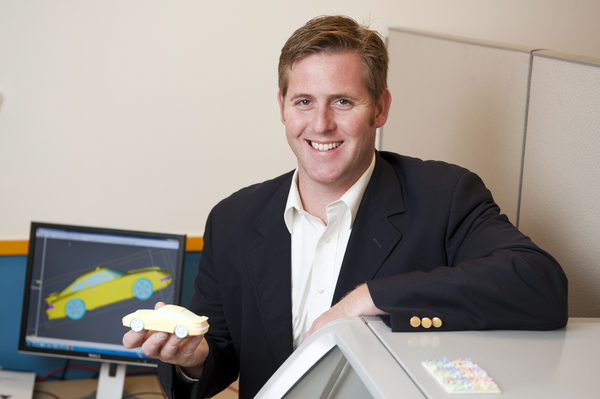3Qs: Will 3-D printing spark a new wave of innovation?

It may sound like science fiction, but it’s anything but. Today, engineers and entrepreneurs can design a product on a computer and, with the help of increasingly accessible 3-D printers, have a prototype in their hands within hours. Tucker Marion, assistant professor of technological entrepreneurship and the Sam and Nancy Altschuler Faculty Fellow and Bornstein Endowed Faculty Fellow, studies industrial innovation and here explains how rapid prototyping is changing product development.
How is 3-D printing changing how entrepreneurs and innovators design and develop new products?
There’s been a lot of buzz about 3-D printing and rapid prototyping recently, but in reality, the technology is 25 years old. What has happened, though, is the cost has gone down dramatically, meaning the way people can approach design and manufacturing is changing rapidly. Cost reduction has allowed small companies—and even individuals—to own these devices and/or contract through low-cost Web-based services.
Some theorize that eventually there will be one of these devices in every household, and consumers will be able to print out new eyeglasses or some computer part to replace something you broke. We aren’t there yet, and we don’t know if that’s where we’re headed, but it’s certainly in the realm of possibility. What is happening now is that this technology is opening up new possibilities for designers, engineers, and entrepreneurs. It’s a lot like what happened with software development in the ’90s and 2000s: Suddenly you had a lot of people able to develop great programs, some of which sparked a new wave of innovation in a field that had previously been very difficult to break into.
It’s allowing individuals to be able to design, validate, and modify their ideas—a democratization of design and engineering. This puts prototypes into the hands of innovators, investors, and potential customers in a way that is much faster and far less expensive than ever before possible.
Does 3-D printing represent the next generation of manufacturing?
There’s some thought that 3-D printers will be the primary tool for the next wave of manufacturing here in the United States, but I’m skeptical about that. It’s a great way to produce prototypes and low quantities of goods, but it’s not fast enough to compete with how we already produce high-volume goods such as injection molding or casting. However, more capable additive manufacturing is certainly where the research in the field is going, whether you’re someone looking to create the next product or someone creating a small run of goods.
The real impact of this is in the manner that teams approach design and iteration. Additionally, these tools have traditionally been available to firms with deep pockets. Cost reduction has allowed them to be much more accessible. The kind of tools that used to require a massive amount of upfront capital are now available for as little as a few thousand dollars, which can be a game-changer for an individual or small collectives of groups interested in developing new goods. Additionally, social sharing of designs on websites such as GrabCAD.com are only accelerating the ability of individuals to innovate collectively. These are exciting times for design, engineering, and entrepreneurship.
Though the basics of this technology have existed for some time, we’re seeing innovations like the ability to produce goods with more than one material—think a toothbrush with a squishy grip—or which incorporate electronics. We’re seeing new ways to quickly make prototypes out of metal and other structural materials. Each of these innovations is opening up new possibilities for the field.
How is 3-D printing affecting entrepreneurship education at Northeastern?
It’s allowing our students to create prototypes and launch real businesses. Take U-Turn Audio, in which a former student, Bob Hertig, designed a new record player and raised more than $200,000 on Kickstarter. The prototype, funded in part through a grant from the university, was built with many 3-D printed parts, which allowed them to fabricate early versions of the components that will be in the finished turntable.
It’s a technology that’s open to anyone willing to put in some time learning how to use computer-aided design programs like Solidworks. We’re going to see a whole new wave of innovation sparked by people who now have the ability to make something they never would have had the resources or skills to produce before.





